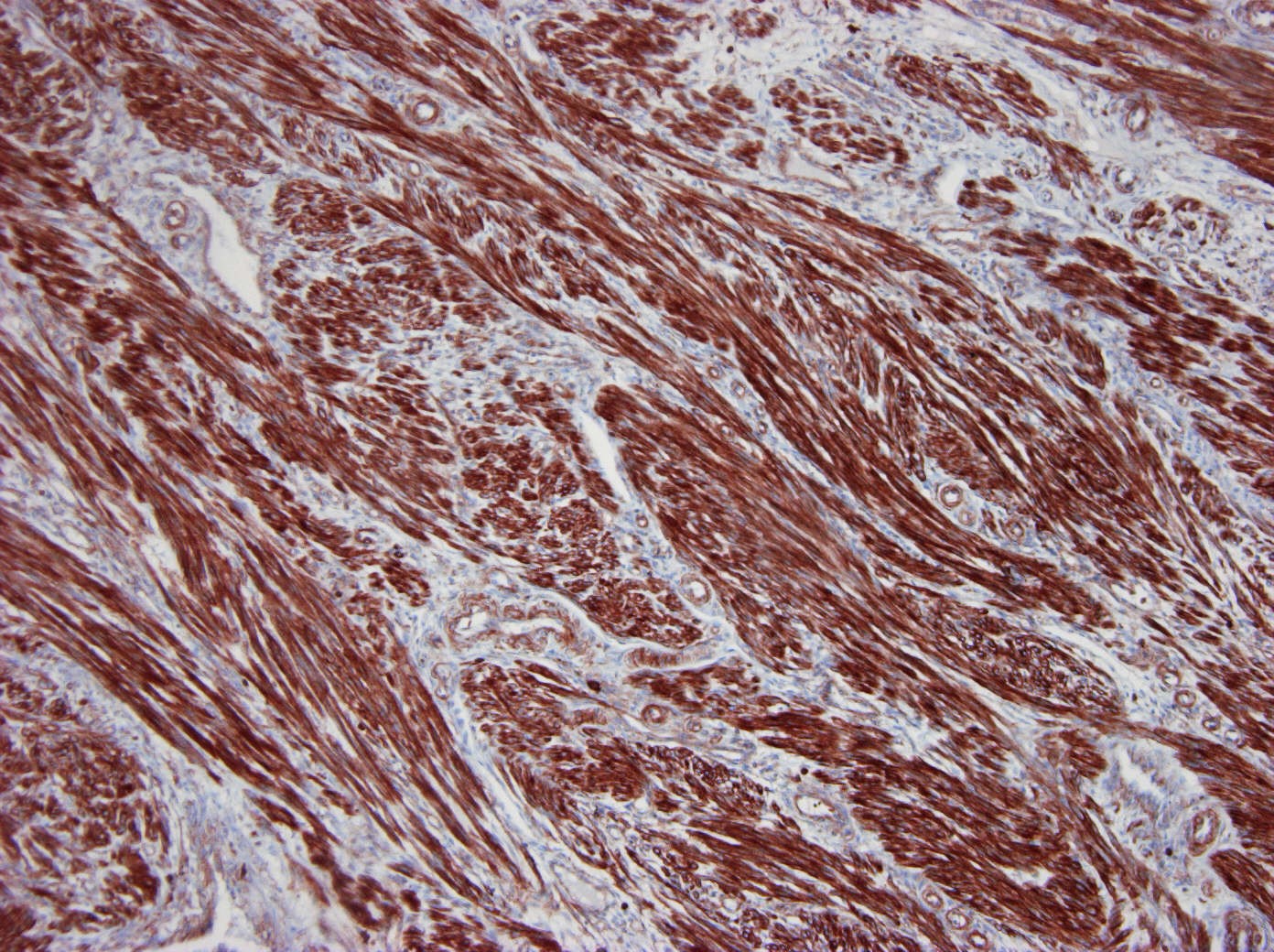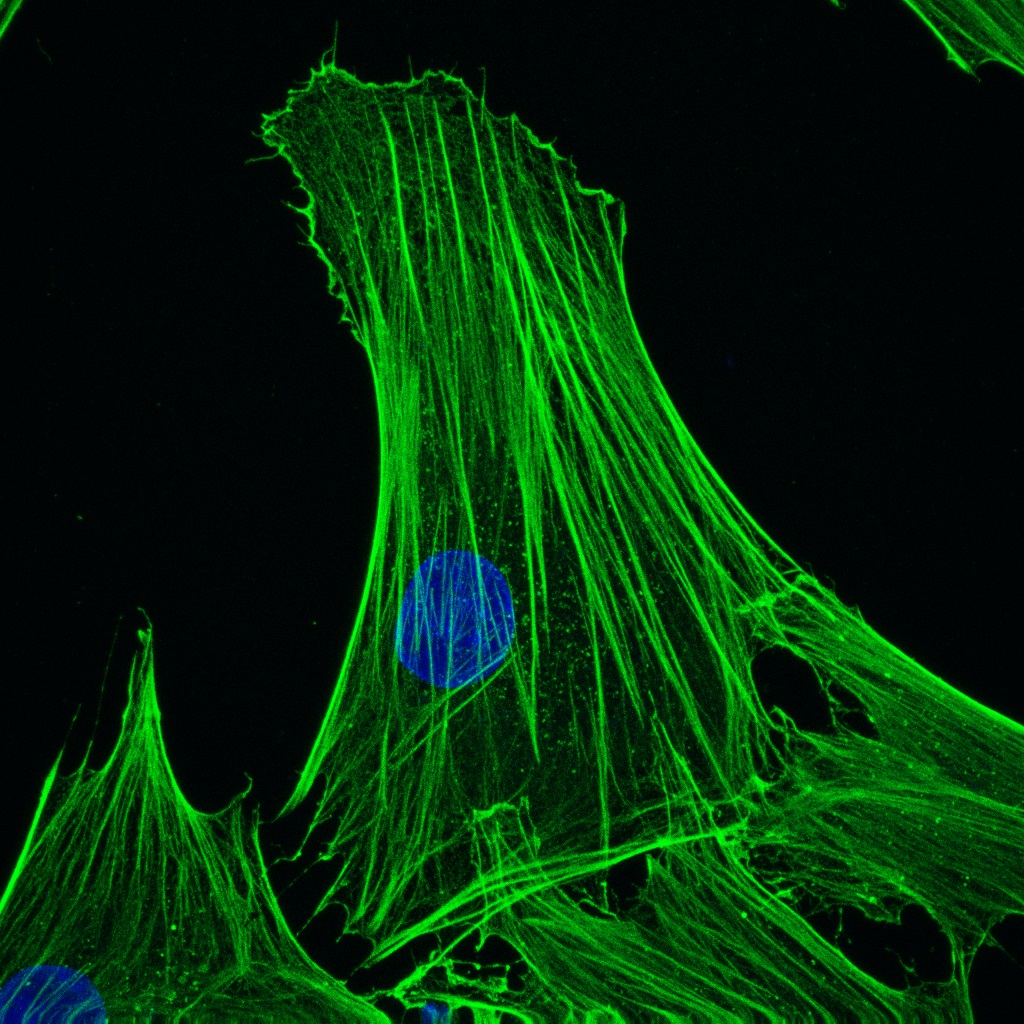Catalogue

Mouse anti actin beta-cytoplasmic
Catalog number: MUB0110P-CE/IVD| Clone | 4C2 |
| Isotype | IgG1 |
| Product Type |
Primary Antibodies |
| Units | 0.1 mg |
| Host | Mouse |
| Species Reactivity |
Chicken Human Mouse Rabbit Rat Swine Zebrafish |
| Application |
ELISA Flow Cytometry Immunohistochemistry (frozen) Immunohistochemistry (paraffin) Western Blotting |
Background
Among the six actin isoforms described in mammals, two are found in virtually all cells (β- and γ-cytoplasmic), two are detected in smooth muscle cells (α- and γ-smooth muscle) and two are present in striated muscles, one predominantly in skeletal (α-skeletal) and one in cardiac (α-cardiac) muscle cells. These actin isoforms differ slightly in their N-terminus, but the sequence of each of these actins is highly conserved in higher vertebRates. β- and γ-cytoplasmic actin play crucial roles during various key cellular processes. Whereas β-actin is preferentially localized in stress fibers, circular bundles and at cell-cell contacts, suggesting a role in cell attachment and contraction, γ-actin displays a more versatile organization, according to cell activities. In moving cells, γ-actin is mainly organized as a meshwork in cortical and lamellipodial structures, suggesting a role in cell motility. β- and γ-actin depleted fibroblasts exhibit distinct changes in motility compared with their controls, suggesting a specific role for each isoform in cell locomotion.
Source
4C2 is a mouse monoclonal IgG1 antibody derived by fusion of NS0 mouse myeloma cells with spleen cells from a BALB/c mouse immunized with a peptide comprising the N-terminal nonapeptide of β-cytoplasmic actin with an acetylated N-terminus (Ac-DDDIAALVV-COOH) coupled to keyhole limpet hemocyanin through the cysteine residue. The antibody does not cross react with other actin isoforms.
Product
Each vial contains 100 ul 1 mg/ml purified monoclonal antibody in PBS containing 0.09% sodium azide.
Formulation: Each vial contains 100 ul 1 mg/ml purified monoclonal antibody in PBS containing 0.09% sodium azide.
Specificity
4C2 is a mouse monoclonal Ig1 antibody highly specific for β-cytoplasmic actin.
Species Reactivity: The epitope recognized by 4C2 is highly conserved. The antibody therefore cross-reacts with many species including protochordates, lower craniates and mammals.
Applications
4C2 is useful for immunohistochemistry on frozen and paraffin-embedded tissues, immunoblotting, flow cytometry and ELISA. Optimal antibody dilution should be determined by titration; recommended range is 1:100 – 1:500 for immunohistochemistry with avidin-biotinylated horseradish peroxidase complex (ABC) as detection reagent, and 1:1000 – 1:5000 for immunoblotting applications.
Storage
The antibody is shipped at ambient temperature and may be stored at +4°C. For prolonged storage prepare appropriate aliquots and store at or below -20°C. Prior to use, an aliquot is thawed slowly in the dark at ambient temperature, spun down again and used to prepare working dilutions by adding sterile phosphate buffered saline (PBS, pH 7.2). Repeated thawing and freezing should be avoided. Working dilutions should be stored at +4°C, not refrozen, and preferably used the same day. If a slight precipitation occurs upon storage, this should be removed by centrifugation. It will not affect the performance or the concentration of the product.
Caution
When used for in vitro diagnostic purposes results must be put within the context of other diagnostic tests as well as the clinical history of the patient by a certified professional before final interpretation. Analyses performed with this antibody should be paralleled by positive and negative controls. If unexpected results are obtained which cannot be attributed to differences in laboratory procedures, please contact us. This product may contain hazardous ingredients. Please refer to the Safety Data Sheets (SDS) for additional information and proper handling procedures. Dispose product remainders according to local regulations.This datasheet is as accurate as reasonably achievable, but Nordic-MUbio accepts no liability for any inaccuracies or omissions in this information.
References
1. Vandekerckhove, J. and Weber, K. (1978). At least six different actins are expressed in a higher mammal: an analysis based on the amino acid sequence of the amino-terminal tryptic peptide. J Mol Biol. 126(4), 783-802.
2. Bassell, G.J., Zhang, H., Byrd, A.L., Femino, A.M., Singer, R.H., Taneja, K.L., Lifshitz, L.M., Herman, I.M. and Kosik, K.S. (1998). Sorting of beta-actin mRNA and protein to neurites and growth cones in culture. J Neurosci. 1998 18(1), 251-65.
3. Dugina, V., Zwaenepoel, I., Gabbiani, G., Clément, S. and Chaponnier, C. (2009). ß- and y-cytoplasmic actins display distinct distribution and functional diversity. J Cell Sci 122, 2980-88.
4. Gallant, C., Appel, S., Graceffa, P., Leavis, P., Lin, J.J., Gunning, P.W., Schevzov, G., Chaponnier, C., Degnore, J., Lehman, W. and Morgan, K.G. (2011). Tropomyosin variants describe distinct functional subcellular domains in differentiated vascular smooth muscle cells. Am J Physiol Cell Physiol. 300(6), 1356-65.
CE Mark
CE
Protein Reference(s)
Database Name: UniProt
Accession Number: P60709
Safety Datasheet(s) for this product:
| NM_Sodium Azide |

Figure 1. Formalin fixed, paraffin embedded human myoma tissue immunostained for beta cytoplasmic actin using MUB0110P (clone 4C2) at a 100x dilution. Note the strong staining of smooth muscle tissue.

Figure 2. MUB0110P (clone 4C2) immunostaining of human fibroblasts in cell culture. Note the strong reactivity for beta cytoplasmic actin in the stress fibers of the cytoskeleton.


